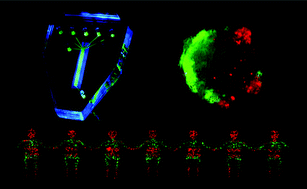This paper describes a microfluidic method to form co-culture spheroids of various geometries and compositions in order to manipulate cell–cell interaction dynamics. The cellular patterning is performed in a two-layered microfluidic device that sandwiches a semi-porous membrane so that flow occurs from the top channel through the membrane to the bottom channel. Arbitrary cellular arrangements are enabled by regulating the geometric features of the bottom channel so that as culture media drains, the flow hydrodynamically focuses (aggregates) cells onto the membrane only over the regions of the bottom channel. Furthermore, when the top channel has multiple inlets, cells can be seeded in adjacent laminar streams, allowing different cell types to be patterned simultaneously in well defined spatial arrangements. Interestingly, the initial cell positioning of certain cell types can result in two juxtaposed non-concentric “Janus” spheroids, rather than homogeneous mixtures or layered shell structures. Therefore, the initial position of cells prior to aggregation can influence the final configuration within a co-culture spheroid. When Janus spheroids were constructed from mouse embryonic stem (mES) cells and hepatocytes, the mES cells differentiated in a spatially distinct pattern dictated by the position of the hepatocytes. This contrasts with uniform mES differentiation observed when co-culture spheroids are formed by the conventional method of randomly mixing the two cell types. This cellular patterning method opens new possibilities for understanding and manipulating interactions between different cell types in 3D.

You have access to this article
 Please wait while we load your content...
Something went wrong. Try again?
Please wait while we load your content...
Something went wrong. Try again?


 Please wait while we load your content...
Please wait while we load your content...